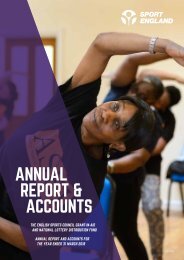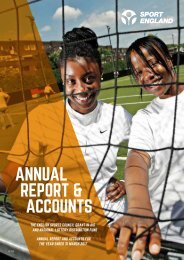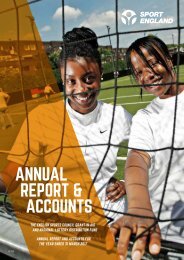sport-england-2016-17-annual-report-and-accounts
You also want an ePaper? Increase the reach of your titles
YUMPU automatically turns print PDFs into web optimized ePapers that Google loves.
TAKING PART<br />
Over the last 12 months, 15 of the<br />
<strong>sport</strong>s we fund including football,<br />
table tennis <strong>and</strong> swimming increased<br />
the number of people taking part<br />
once a month, while <strong>17</strong> saw a decline.<br />
These trends, <strong>and</strong> an analysis of the data driving<br />
them, helped to inform our investment in NGBs<br />
between 20<strong>17</strong>-21.<br />
Investment decisions were made by the Board<br />
in December <strong>2016</strong>, <strong>and</strong> once again in February<br />
<strong>and</strong> March 20<strong>17</strong>.<br />
In May <strong>2016</strong> we discussed each NGB’s strategy<br />
<strong>and</strong> pinpointed any alignment with Towards<br />
an Active Nation. We found that most NGBs are<br />
working with core market customers, <strong>and</strong> each<br />
NGB has agreed an exact number of customers<br />
it can influence, <strong>and</strong> how.<br />
Crucially, our insight helped us to identify <strong>and</strong><br />
agree what the typical patterns of behaviour<br />
are for consumers of each <strong>sport</strong>. In many<br />
cases, that means ‘success’ can be measured<br />
in different ways from our previous weekly<br />
30-minute measure.<br />
An investment range was agreed for each NGB,<br />
with the quality of their implementation plans<br />
determining the final investment figure. We are<br />
planning to invest £238 million in NGBs (including<br />
investment in talent development) over the next<br />
four years. NGBs will also have the opportunity<br />
to access additional funding through other<br />
investment programmes, for example through<br />
mass market <strong>and</strong> tackling inactivity funds.<br />
This remains a significant total but is<br />
approximately 33% lower than the 2013-<strong>17</strong><br />
funding cycle, fulfilling the strategy promise of<br />
a reduced subsidy. A large number of NGBs have<br />
adapted by developing plans to increase their<br />
non-public income <strong>and</strong> redesigning the way they<br />
deliver <strong>sport</strong> to be more efficient. Sustainability<br />
plans <strong>and</strong> commercial strategies, for those<br />
needing to reduce their reliance most, will be in<br />
receipt of our monitoring <strong>and</strong> support in 20<strong>17</strong>-18.<br />
THE RESPONSE FROM NGBS TO THIS<br />
NEW WAY OF WORKING HAS BEEN<br />
LARGELY POSITIVE DESPITE THE<br />
REDUCTION IN FUNDING<br />
This represents a greater maturity in the<br />
relationship between Sport Engl<strong>and</strong> <strong>and</strong> NGBs,<br />
with recognition that access to public money is a<br />
privilege not an entitlement.<br />
Another key difference with our future funding is<br />
a focus on under-represented groups, particularly<br />
those on lower incomes <strong>and</strong> from more deprived<br />
communities. That’s where subsidy is needed<br />
most – <strong>and</strong> <strong>sport</strong>ing habits are more vulnerable<br />
to day-to-day interruptions such as a friend<br />
dropping out of an activity usually done together.<br />
Reducing these inequalities has already been,<br />
<strong>and</strong> will continue to be, a central focus of our<br />
approach to both NGB <strong>and</strong> non-NGB core<br />
market investment.<br />
Investing in talent<br />
Recognising the particular needs of those with<br />
talent <strong>and</strong> the aim of international <strong>sport</strong>ing<br />
success for the Engl<strong>and</strong> <strong>and</strong> Great Britain<br />
teams, we will invest £85 million into talent<br />
<strong>and</strong> high performance programmes across<br />
50 different <strong>sport</strong>s between 20<strong>17</strong> <strong>and</strong> 2021.<br />
This supports the 60,000 athletes in specific<br />
talent development programmes.<br />
THAT POSITIVE EXPERIENCE,<br />
FOR THOSE WHO DO OR DON’T<br />
MAKE THE PODIUM, IS A DRIVER<br />
OF OUR INVESTMENT<br />
Our future champions are in this group. Identifying<br />
<strong>and</strong> nurturing their ability is why the talent system<br />
exists, but their needs alone should not dominate<br />
the experience of the rest.<br />
That positive experience, for those who do<br />
or don’t make the podium, is a driver of our<br />
investment, along with a more inclusive talent<br />
pool which should make our international teams<br />
representative of our diverse population.<br />
In December <strong>2016</strong> we signed a Memor<strong>and</strong>um<br />
of Underst<strong>and</strong>ing with UK Sport to align our<br />
respective talent strategies <strong>and</strong> investments.<br />
In line with that document, investment decisions<br />
in jointly-funded <strong>sport</strong> talent systems have been<br />
made jointly.<br />
We champion a responsible approach<br />
to developing <strong>and</strong> retaining talent <strong>and</strong> have<br />
had regular dialogue in <strong>2016</strong>-<strong>17</strong> <strong>and</strong> input into<br />
the Duty of Care review, which was published<br />
in April 20<strong>17</strong>. We are now assessing<br />
its implications for our talent investment.








